Cyber Monday eCommerce: 20 *Last-Minute* Hacks to Boost Conversions



While Monday blues are the norm, there’s one Monday that makes shoppers and brands happy.
Tadaa!
Cyber Monday.
A sizable percentage of eCommerce brands are always underprepared for Cyber Monday.
To get you up to speed, here’s a list of growth hacks we’ll be exploring today:
Here are some last-minute 20 eCommerce growth hacks you can apply today!
Yes, we mean that you offer 50% off, only when a shopper’s cart value is higher than your AOV.
30% off when it’s the same as your AOV, and 20% off when it’s below your AOV.
And here’s why this Cyber Monday tactic converts: 62% of shoppers spend an average of 2 hours scouring the internet for promotional offers.
This means: your best shoppers (people who consistently buy from you) who have already converted during Black Friday, get another reason to buy more. Without feeling left out.
The rest? They get what they were waiting for: a bigger discount. Plus, you don’t lose on margin and customer retention. 🙂
Here's an example of a Cyber Monday marketing campaign from Baggu, putting this tiered discount tactic to use:
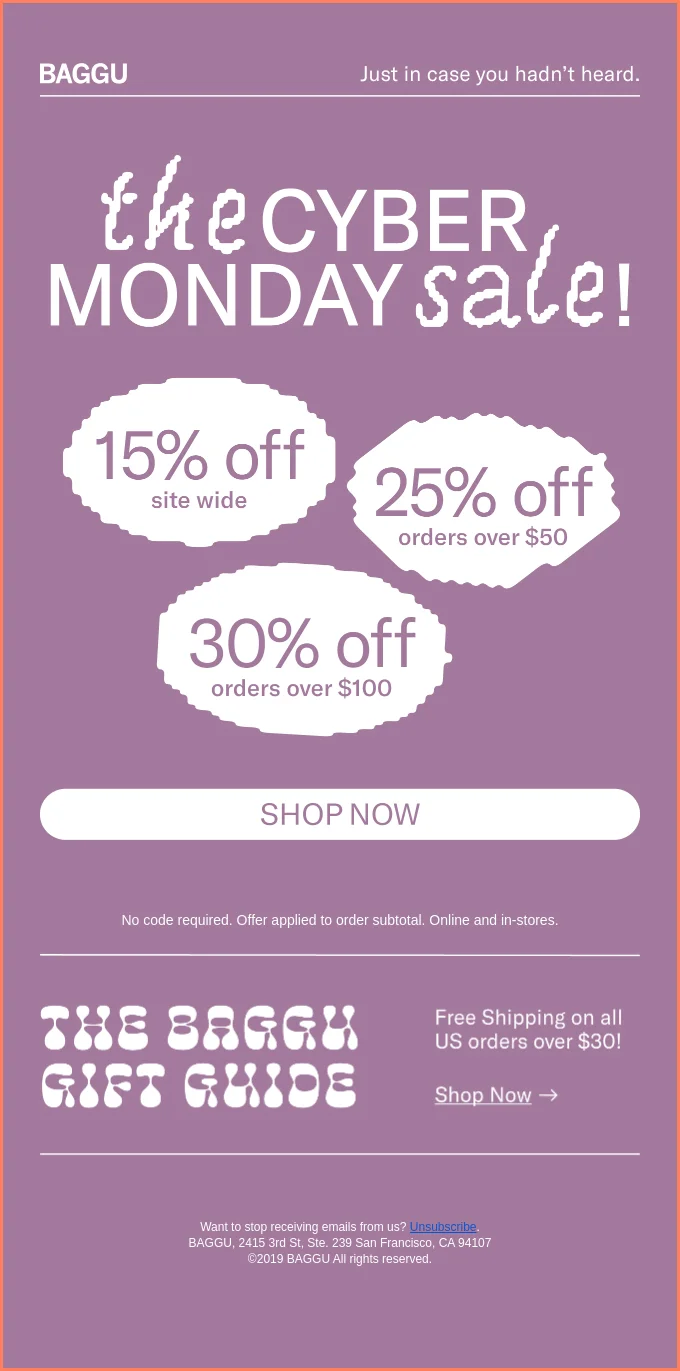
Pro Tip: It's important to evenly distribute the discounts and promotional deals because the Cyber Monday marketing campaign isn’t limited but extends for a week.
Don't miss 17 Proven Ways to Boost Average Order Value (+ Examples)
Cyber Monday’s last-minute shoppers aren’t that hard to please: ship fast, ship free, and get it to them in 2–3 days.
A third of last-minute shoppers choose where to buy based on delivery speed, most won’t shop without free shipping, and almost 9 in 10 want their order in 2–3 days.
However, you can take your Cyber Monday marketing up a notch: ensure they know that Cyber Monday is the last day to catch a sizeable discount with free shipping – here’s how:
Roll out ‘Ready to ship’ as PLP filters and ‘Arrives before Hanukkah if you order in XX:XX:XX’ microcopy on product detail and cart pages (this way, they know this is their last chance to get their purchases delivered for free, in time for the Holidays).
Up the urgency in your Cyber Monday emails as well, as Josie Maran does – note how they not only offer free shipping but also free gifts along with a discount, but only for one day:

Don't forget to check out:
Some Cyber Monday shoppers often get overwhelmed with choices. They need quick signals that a product is safe, popular, and worth buying. This is exactly what social proof can help with.
In fact, nearly 70% of shoppers will trust a recommendation from people whom they don’t know.
All you have to do to use social proof smartly in your Cyber Monday marketing campaigns – back purchase decisions up with:
User action notifications like “x people have added this to cart”, or “top wishlisted product for Christmas.” Or, you can show recent sale notifications.
The idea is to nudge shoppers to explore out of FOMO and curiosity, and also add a layer of urgency. Here are two great examples:
a) Floliving uses recent sale notifications on its homepage to attract the user’s attention, without interrupting UX:

b) New Air adds a dynamic sale counter on their product pages – a constant reminder that time (and stock) is running out:
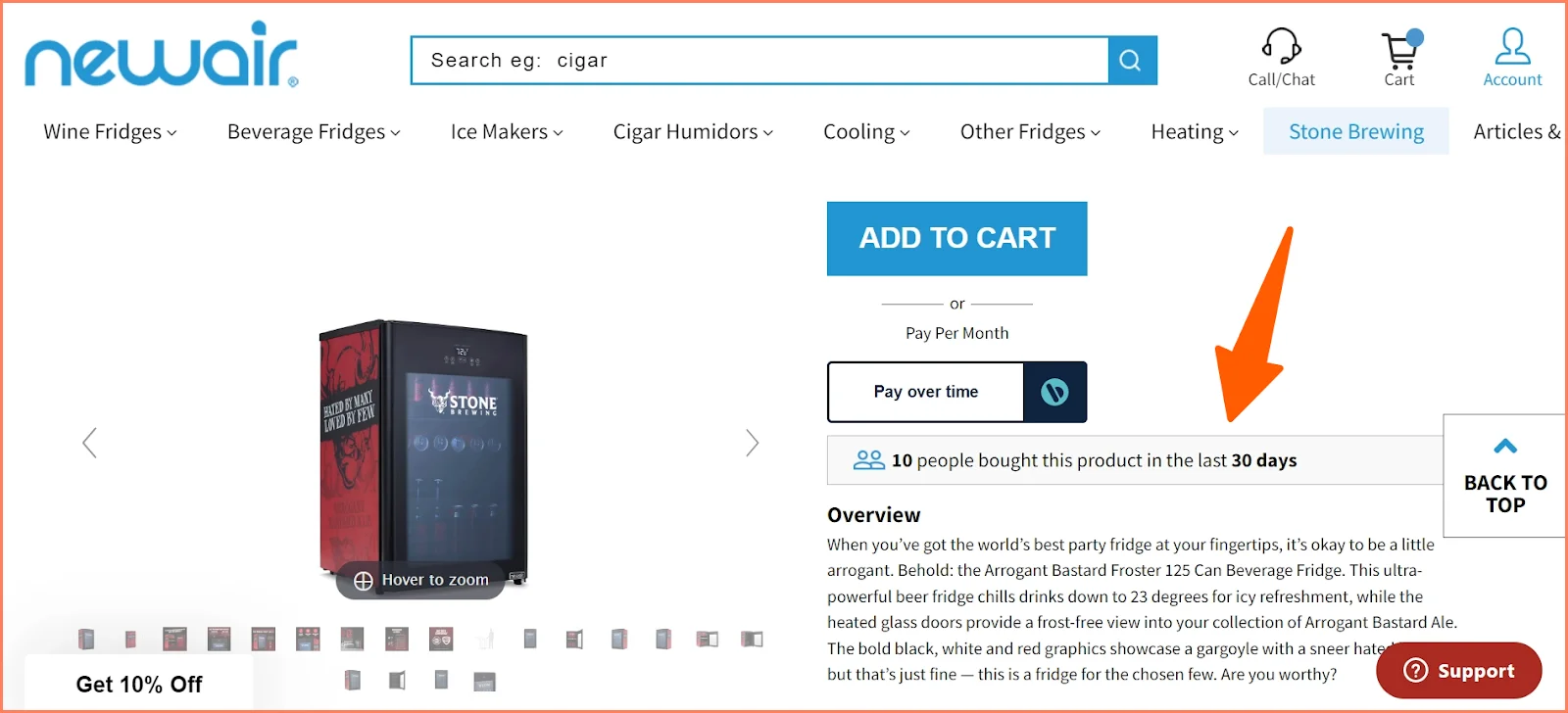
Learn more about eCommerce social proof: What, why & how (with proven examples)
Last-minute Cyber Monday shoppers need more than a good product and free shipping: they need it to be easy to buy.
This is why you should offer curbside pickup, international shipping, flexible payment options, and a pain-free returns experience.
Here’s some proof as to why:
Here are some great Cyber Monday marketing examples, putting this tactic into action:
Bose makes Cyber Monday shopping easy as pie. They offer conveniences like free return shipping and 2 day shipping with easy installment payments (note how they also add a minimum order value):
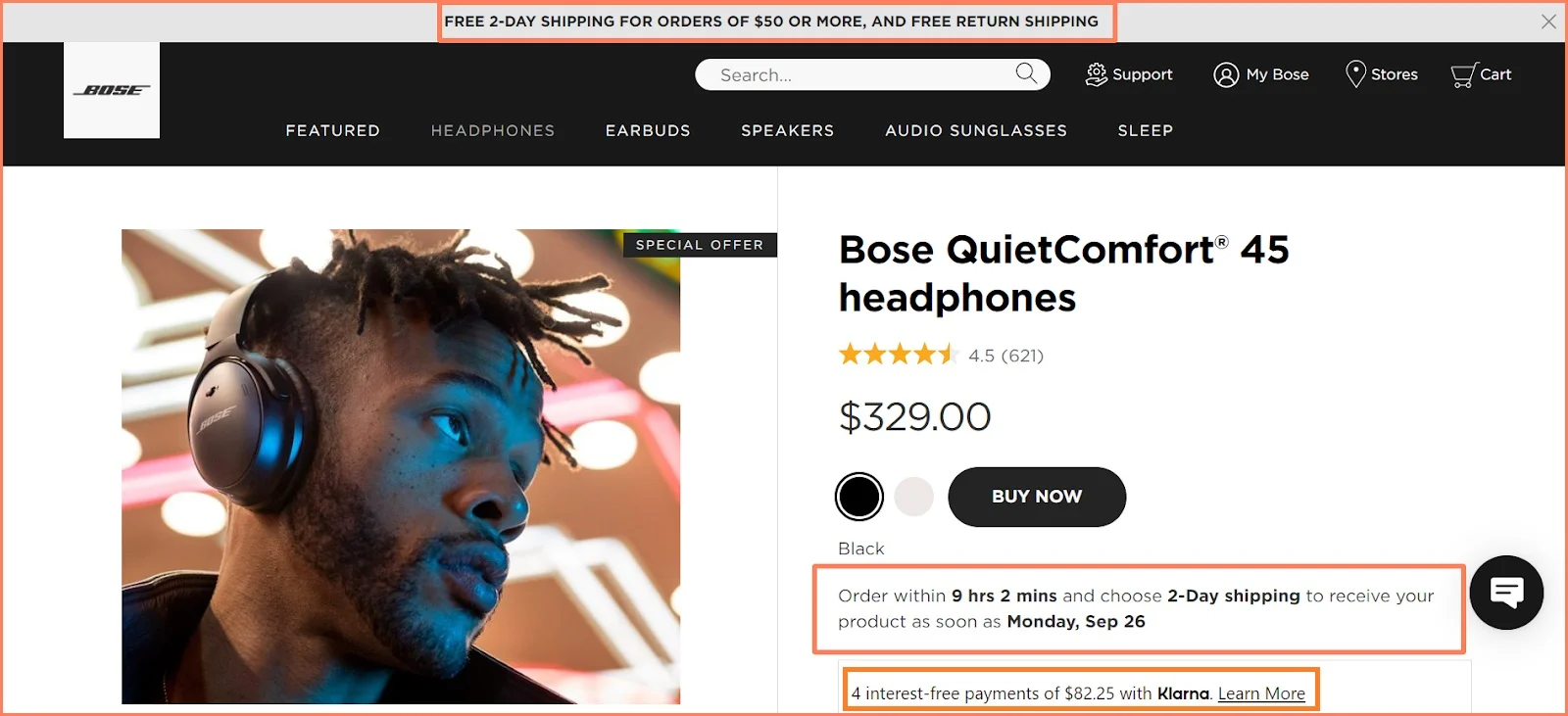
They also up the trust factor with risk-free trials (e.g., 90-day return window) to encourage first-time buyers towards a purchase.
Meanwhile, Best Buy drives urgency by offering personalized geolocation driven in-store pickup option (note the 1 left at your store):
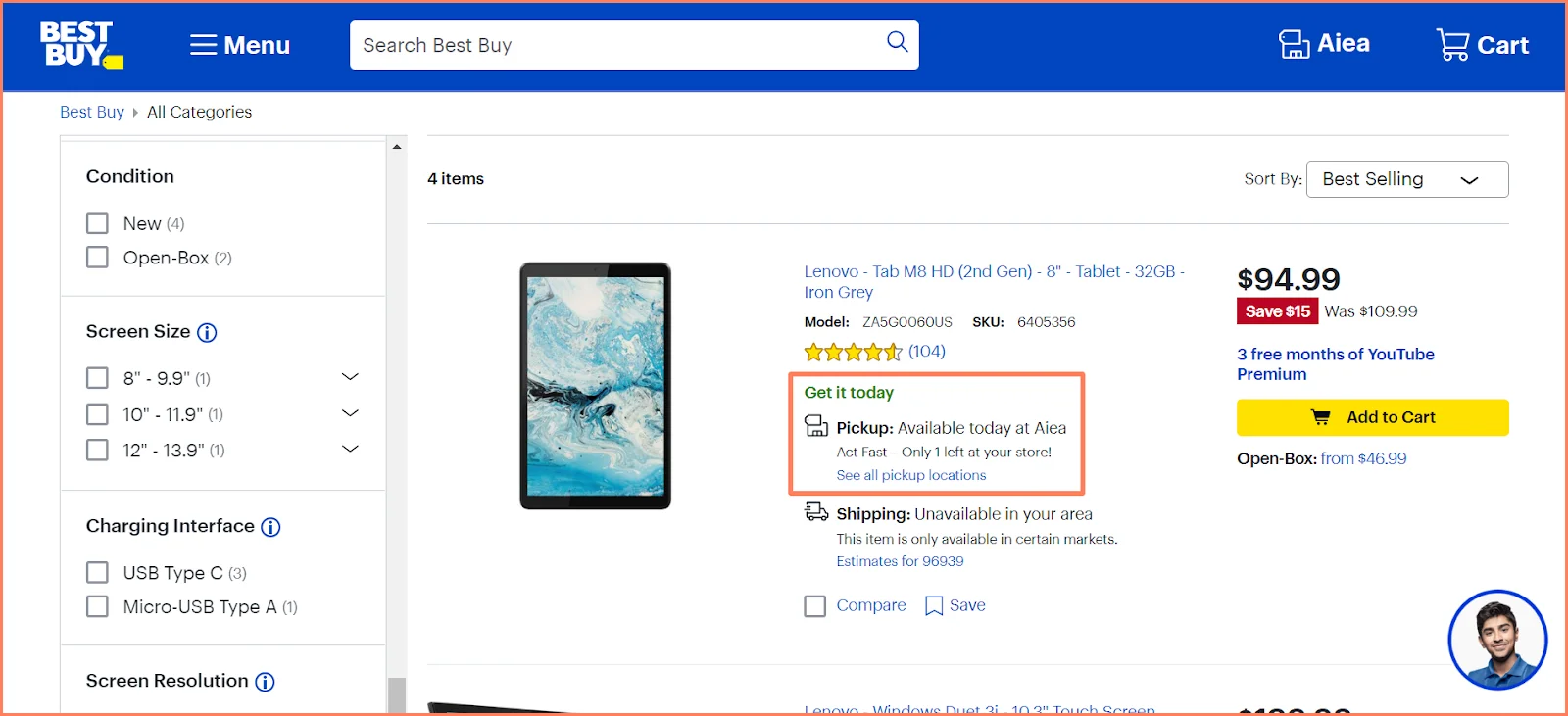
We’ve already shown how you can make tiered Cyber Monday offers work for everyone. However, you can use the Cyber Monday sale to give your existing shoppers more.
And here’s why you should: Loyal shoppers spend 67% more than new ones, referrals from members are 2× more effective at 25% of the cost, and a strong loyalty program can drive 20% of total profits. Here are some Cyber Monday marketing strategies:
Offer future rewards to recent purchasers (e.g., Black Friday shoppers): like 3× loyalty program rewards points (or cashback on future purchases). They’ve already trusted you once, so offering rewards can lock in more repeat purchases.
Use front-loaded incentives for inactive shoppers. Some examples: exclusive Cyber Monday pricing, members-only discounts, or instant referral bonuses.
Make sure you keep signups and follow-ups frictionless – like, targeted offers with one click sign-ups, and targeted product picks and perks. Here’s a great example of exclusive member Cyber Monday deals from Nine Volt:

Remember: Once a loyal customer, always a loyal customer. 59% of Americans say that once they become loyal to a brand, it stays the same throughout their lifetime.
Off-site social proof is just as important as on-site social proof. The right influencer partnership can make or break your Cyber Monday Sale.
Why? Shoppers already use social media to plan their shopping. And according to Adobe, a shopper who’s come by an influencer’s recommendations during Cyber Monday is 6X more likely to convert.
So, one of the key aspects here is to choose the right influencers. Collaborate with the ones who have genuinely used and endorsed similar products.
Explore creative content formats that resonate with your target audience. Instead of just product reviews, ask influencers to create interactive content like live Q&A sessions, hands-on tutorials, or “day-in-the-life” videos featuring your products.
Another format that you can explore is aligning your collaboration with ongoing influencer campaigns to tap into their existing audience engagement. For example, if an influencer is running a series on holiday gift guides, integrate your product into that series. This ensures your product benefits from the influencer’s current audience focus and engagement. Here’s a great example of this Cyber Monday strategy in action from Black Rifle Coffee:

Pro Tip: You can repurpose influencer-generated content into your Cyber Monday advertising campaigns. Authentic testimonials and user-generated content can be more compelling than traditional ads. Use clips from influencer unboxings or product use.
Cyber Monday shoppers are particularly responsive to deals that have a tight deadline–which helps prevent decision paralysis and prompts quicker purchases.
Here’s how you do it:
Introduce hourly flash sales with increasing discounts throughout Cyber Monday.
Rotate the discounts across the day (say something like, “Cyber Deals Every Hour – Up to 80% OFF”). Start with 10% off with one batch of products, then move to 20% with another batch, then 30%, and beyond. This keeps shoppers checking back for the next drop (and getting the best discount)
Offer special bundles only available during certain hours on Cyber Monday (e.g., “Happy Hour Bundles” 2–4 PM).
For subscription brands, this doubles as a trial alternative without locking buyers in. But do ensure you promote in advance through email and social media to build anticipation (and retarget engagers through ads and emails).
Here’s a great example of a Cyber Monday limited edition bundle from Ancestral Supplements – note how they increase the perceived value of the already discounted bundle with free shipping and free gifts worth $34.98:
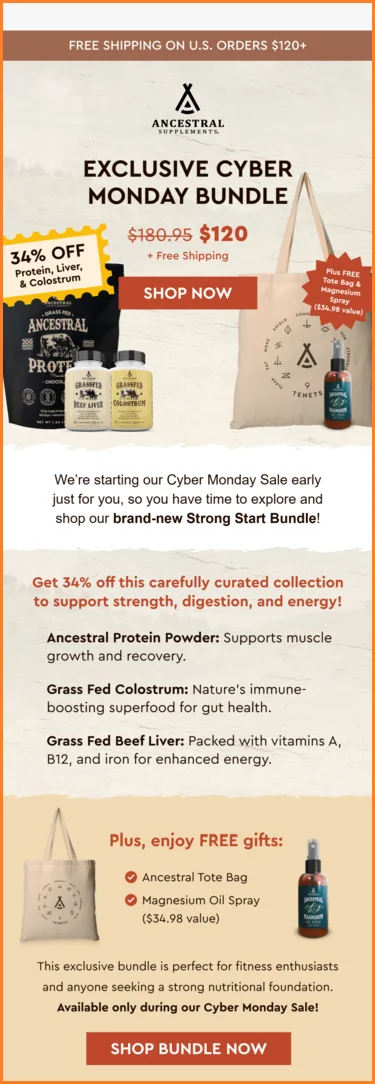
Pro Tip: Incorporate language that emphasizes limited availability or a deadline in your product descriptions. For instance, phrases like “Only 50 items left” or “Offer ends in 2 hours” can push shoppers to act quickly.
Also read: Limited-Time Offer: 18 Compelling Examples + How To Copy Them
What better way to create urgency than with countdown timers in your Cyber Monday promotions!
The idea here is that: Cyber Monday, for most brands, is the last day of the biggest discounts. Here are some tips to convert Cyber Monday shoppers with countdown timers, placed directly on:
Landing, product, and checkout pages to show how much time is left for a specific deal/offer. If you have a flash sale on a popular item, show a timer showing “This exclusive Cyber Deal ends in 1 hour.”
Your ‘Cyber Monday is coming to an end’ promotional emails. All you need: a super creative subject line that shows the time left + a dynamic timer that counts down with some personalized reccos within the email.
Exit-intent pop-ups to compel last-minute shoppers to grab the deal. Here’s a great example from Terra Origin. Note how the pop-up’s copy complements the visual and how the size of the dominant text is 2x bigger than the secondary text (to emphasize the key messaging and nudge shoppers to hit the CTA button):

Ideally, it should be visually different from your Black Friday landing page. Why? To ensure shoppers who’ve shopped your Black Friday sale see something different.
Here’s a checklist for your Cyber Monday landing page:
Here’s a great Cyber Monday landing page example from Moment (note how they feature support options in the header as well as multiple interactive filters):
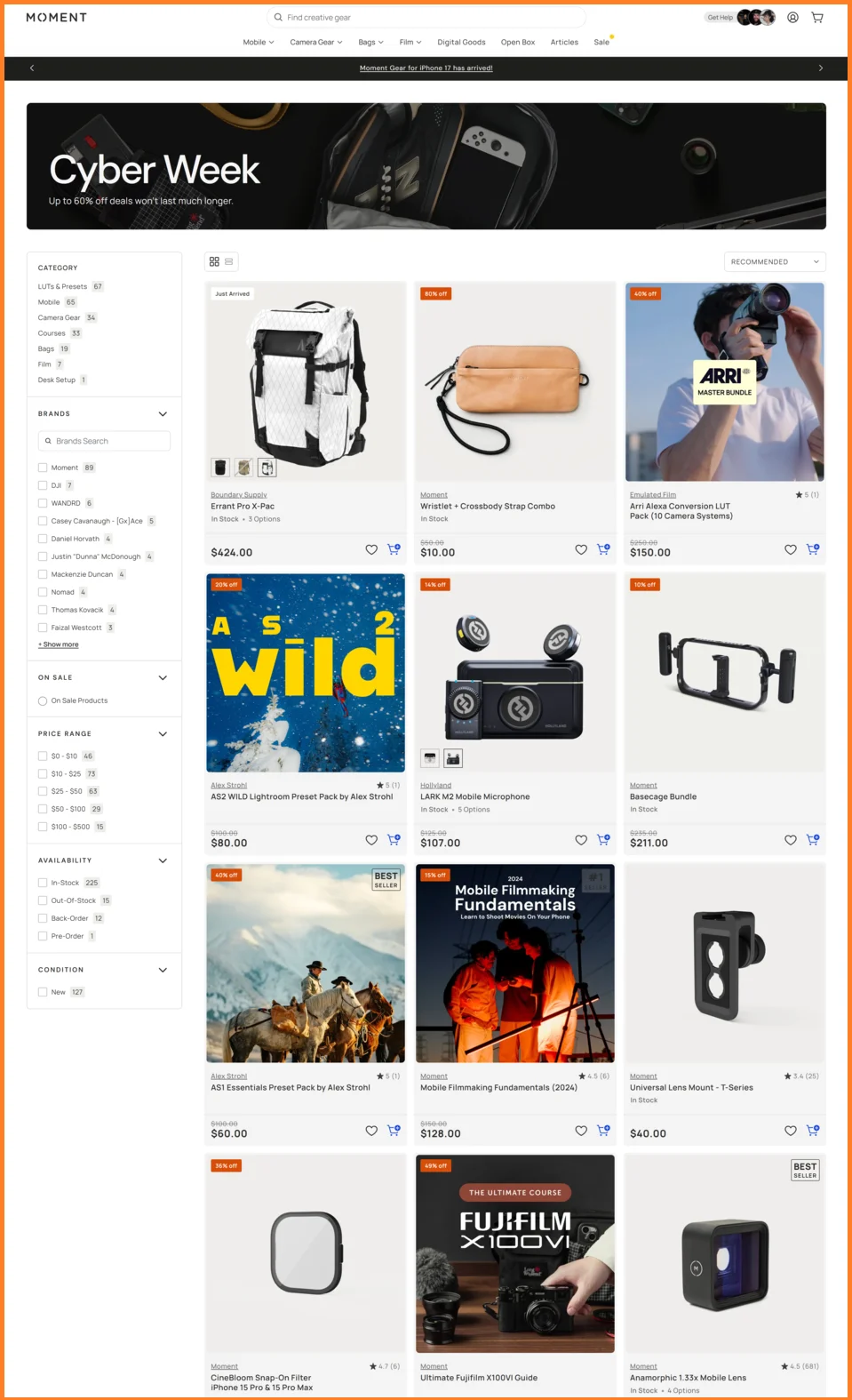
Nothing feels safer than “try before you buy.” Here’s how to effectively promote free trials during Cyber Monday:
Position your Cyber Monday trial as risk-free (“No credit card required”) – like Dollar Shave Club offers a "first box free" to let new shoppers test their razor subscription before making a long-term purchase.
Show the full value upfront – also, add urgency with limited spots or time-bound offers.
Use free trials as part of exit popups to catch abandoners (“Don’t leave without trying it free!”).
Also, ensure signing up for the free trial is simple and frictionless. Reduce form fields and allow guest checkout or social login.
This approach can build trust and provide tangible proof of the value your product delivers–ultimately leading to higher conversion rates.
Most purchases during Cyber Monday are gifts. By curating gift suggestions, you simplify the buying process for shoppers who are exploring options but need guidance to make a purchase decision.
Here’s how you structure your Cyber Monday gift guide:
By budget: Add quick sections like “Gifts under $50” or “Splurge-worthy picks over $100.” (AI can help automate what filters and products show)
By recipient: Segment for “Gifts for Him,” “For Her,” or “For the Tech Enthusiast.”
By urgency: Highlight last-minute gift options with fast shipping or ones with instant delivery (gift cards, e-vouchers).
By trust signals: Feature best-sellers, reviews, and ratings to reassure buyers they’re picking proven favorites.
Here’s a great Cyber Monday gift guide landing page example from Maurices – note how they not only feature gifts, holiday looks, but also alternate buying options like gift cards, loyalty points, and more:
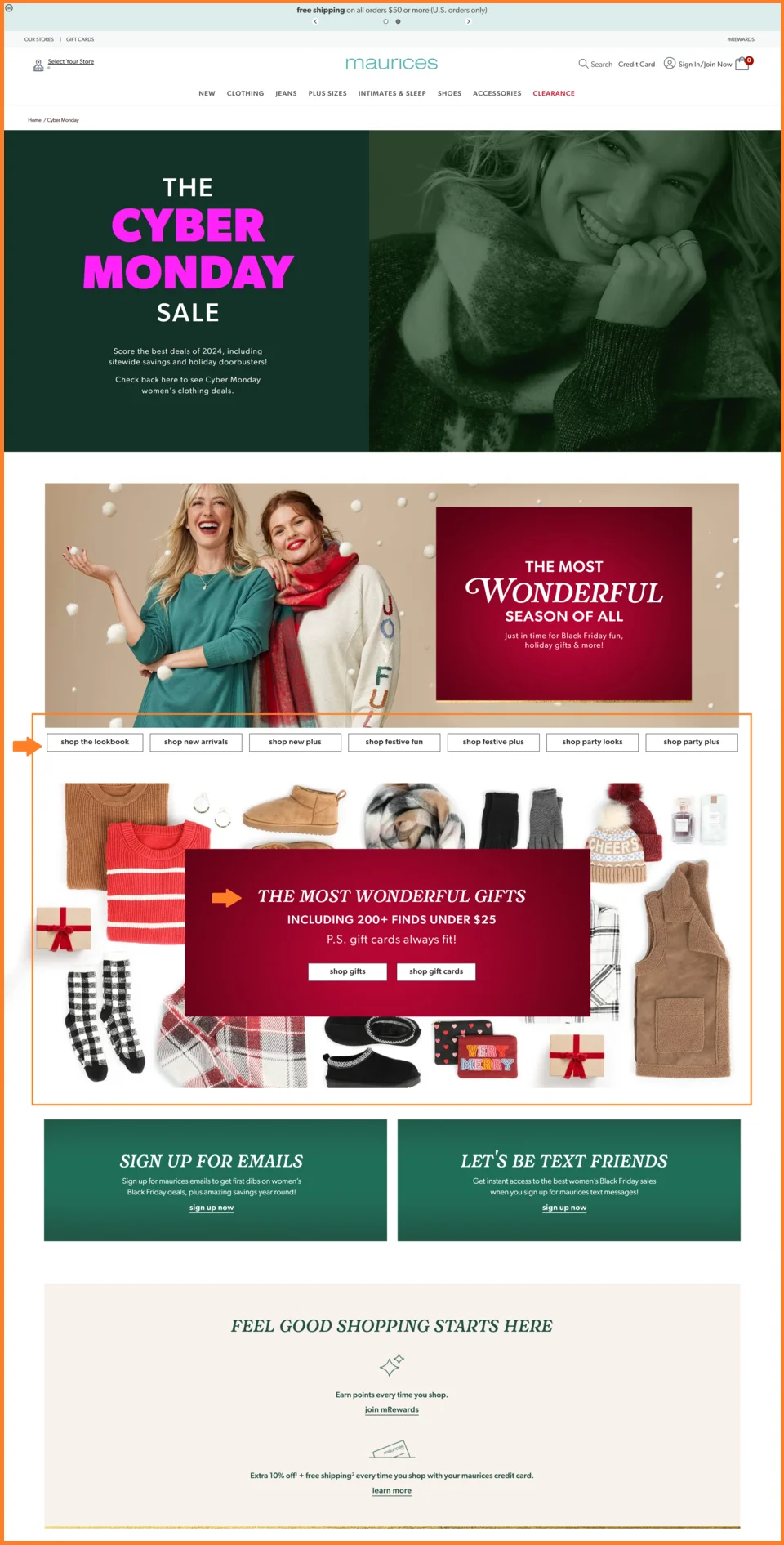
Cyber Monday is going to be a massive rush hour. Shoppers won’t have the time. With the clock ticking, you can simulate the traditional buying experience in chat.
Here’s how to make it work:
Have ready replies for the big questions like “Will it arrive by Christmas?” or “What’s the return policy?”
Pop up as a nudge if someone stops at checkout or spends too long on the product page, say something like, “Before you go, want me to help you find the fastest shipping option?”
Automatically set nudges to trigger, when there’s not much time left on your sale countdown – say something like, “This deal wraps up in two hours, but I can help you lock it in now.”
Suggest add-ons, like “Most shoppers pair this with the holiday bundle + it ships free today.”
Remember: 79% of shoppers prefer live chat due to its instant response time. Also, close to 50% of shoppers opine that having a support person answering the question in the middle of a purchase decision is a strong brand quality.
Cart abandonment rates spike during Cyber Monday, often crossing 80%. The fix isn’t all that complicated: cart recovery emails still convert at around 18% and can add more than $8 in revenue for every email sent.
Here’s what you should always include in your Cyber Monday cart abandonment emails:
Urgency: Subject lines like “Tomorrow is too late” or “time’s almost up on your cart” can make the deadline hard to ignore.
Deadlines: Spell out a clear time window like a 24-hour countdown so shoppers know they need to act fast.
Reciprocity: Copy like “We kept this for you” makes the shopper feel you’ve done them a favor.
Strikethrough pricing: Show what they’re saving in a way that feels tangible.
Trust factors: Cover the obvious objections: – What if I can’t return it? – Shipping costs are too high – What's the warranty?
Low-stock cues: Remind them their product may sell out if they wait.
Withings nails this in their Cyber Monday cart abandonment email, with bold urgency copy, clear deadlines, and reassurance on returns, shipping, and warranty:
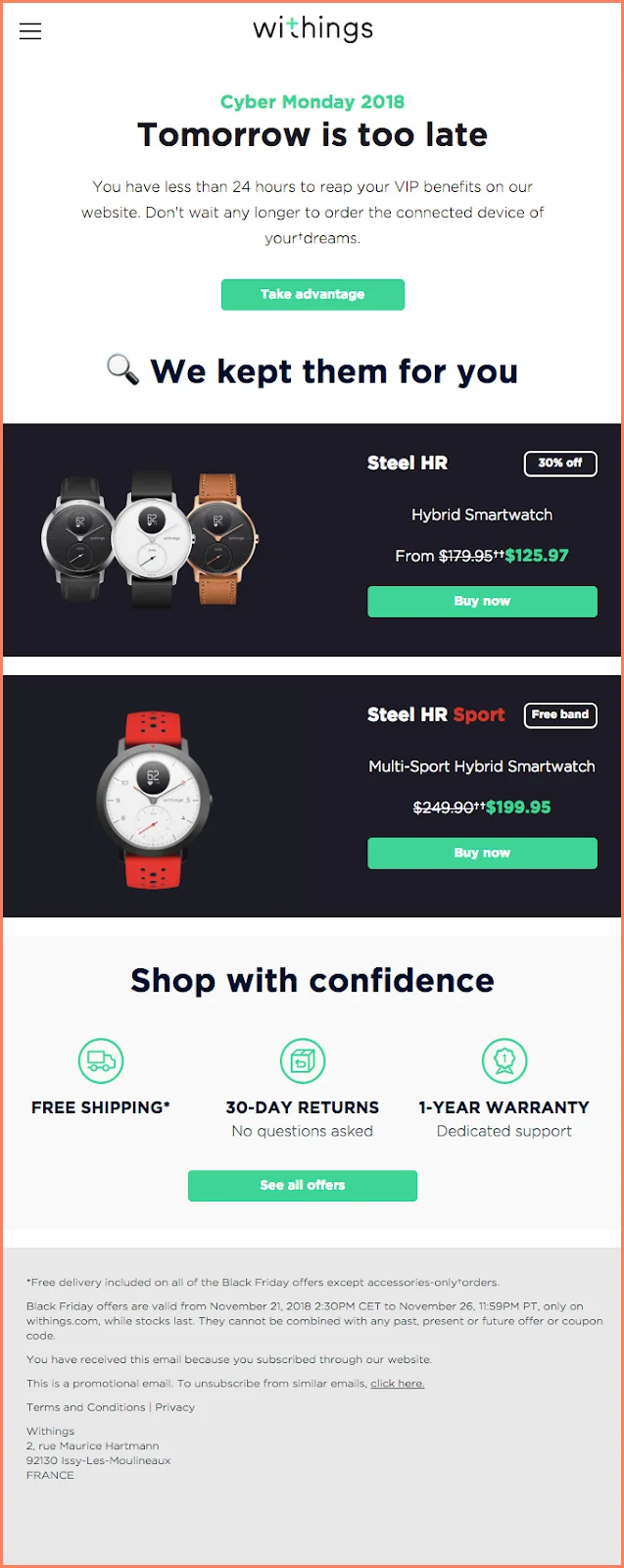
Pro Tip: Switch up your cart abandonment flow for Cyber Monday. Don’t stretch it across three days. Inboxes are already too crowded. Instead, send two emails within 30 hours: the first as a simple reminder, the second with reciprocity and a stackable discount (“Here’s an extra X% off — we saved the Cyber Monday price for you”).
For the final push, skip email and send a SMS to cut through the clutter. Fun fact: up to 60% of cart recovery emails lead to recovered sales within the first 24 hours.
Fix cart abandonment rates with these 17 Unconventional Ways To Reduce Shopping Cart Abandonment
Curiosity works because people like the thrill of the unknown. On Cyber Monday, you can use that to get more opens and clicks.
Design Within Reach did this with a simple subject line in one of its Cyber Monday marketing campaigns:
“Score! It’s Cyber Monday: Mystery deal revealed.”
It makes you want to click just to see what’s inside. You can do the same with: hidden promo codes, surprise gifts at checkout, or deals that only unlock once someone adds to cart.
The important thing is to make the reveal feel worth it, whether that’s a big discount, free shipping, or a bonus gift.

Also read: 14 eCommerce Loyalty Programs Backed By Science (Examples)
Hashtags on social media work the same way categories do on an online store. They help people find what they’re looking for. On Cyber Monday, shoppers love sharing their “haul,” and that’s where you can step in.
Ask shoppers to post their orders with your hashtag and give them a reason to do it: maybe a giveaway or a gift card. It’s worth it, because studies have proven that shoppers pay an average of $59 more than the original price of the gift card. But that’s not the best benefit.
You can share some of these posts on your own feed. Real photos and reactions from shoppers feel a lot more trustworthy than polished studio shots.
Also, you can even turn your entire Cyber Monday social plan into a live stream event. Go live on Cyber Monday, announce winners, show off hauls, and drop surprise deals for people following the hashtag. It creates buzz, keeps shoppers engaged, and gives them a reason to stick with your brand.
Here’s a great example from sewingmachinesplus.com with their Cyber Monday live stream:
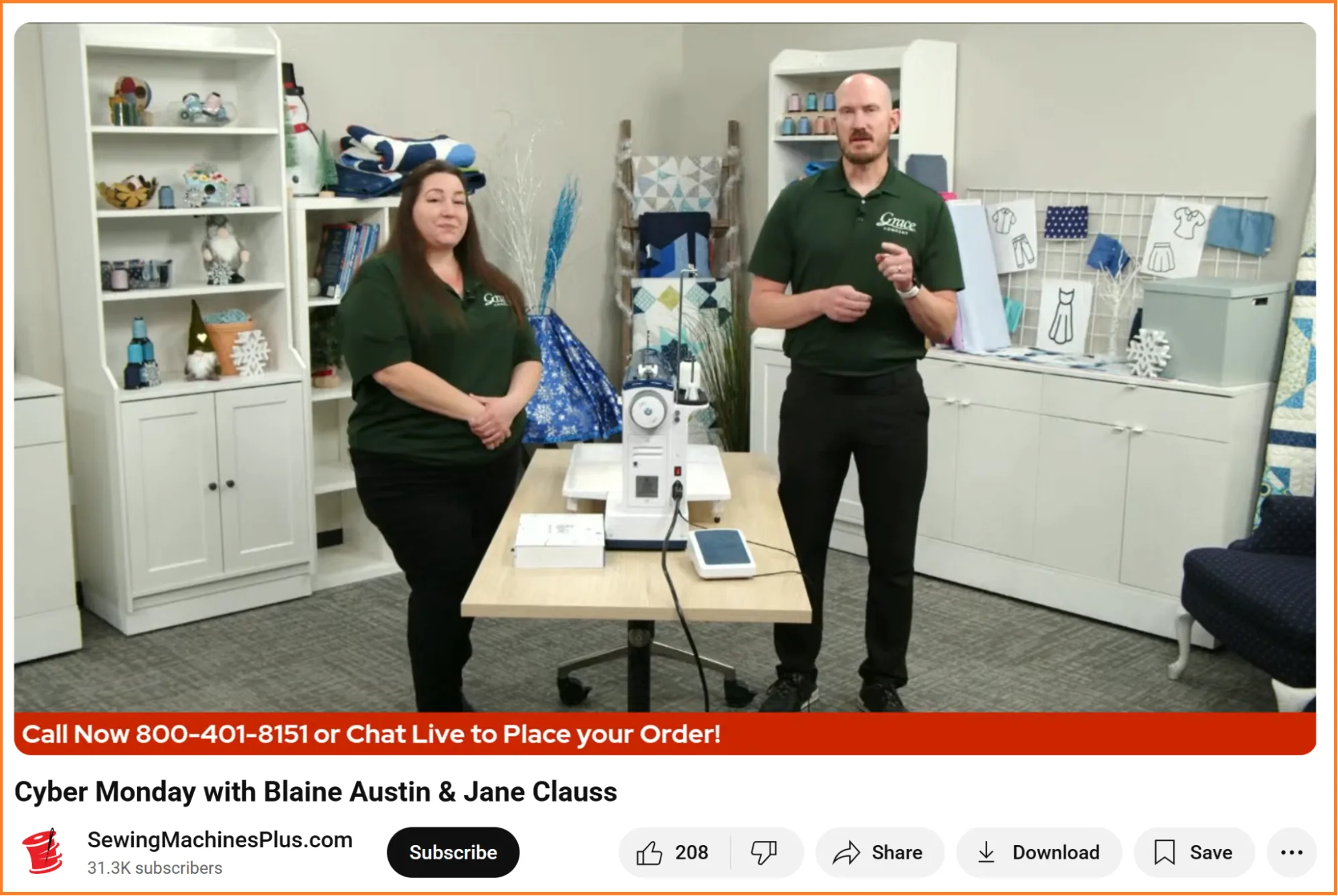
Also read: The Most Creative Black Friday Campaigns - in eCommerce
Popups may feel interruptive, but they work – only when they offer clear value. That’s all there is.
Seasonal email opt-ins convert at nearly 12%. This is why you should work towards building a list of people to send Cyber Deals to, way before Cyber Week arrives.
The trick is to make the offer clear and easy to process.
During Cyber Week, lead with the number, like “Get an additional $30 off orders over $150.” While the dollar amount jumps out and makes the value obvious, you can also test extra purchase discounts or BOGO offers (ideal for increasing AOV without hurting profit margins).
However, before Cyber Week arrives, it doesn’t always have to be a discount. It can be something as simple as asking to get a wishlist started. Some brands use pop-ups to offer a valuable resource like a guide, an ebook, or a compressed PDF. For example, pop-ups offering subscriptions have a conversion rate of 7.49%.
Here’s an example of what an engaging email opt-in pop-up looks like. It offers new users 20$ off on any orders worth $150+:

If you’re late to the party, you can still salvage a win.
You can come up with something creative that isn’t difficult to create, just a few hours before the sale begins.
All you need to do is: retarget your site’s visitors over the last 180 days and segment by categories viewed. This way, you can easily build targeted retargeting Cyber Monday campaigns, showing products shoppers would actually be interested in.
Which is exactly what Emmiol does with their Cyber Monday ad – note how they show ‘Men Fashion’ in the ad to target a specific audience segment:
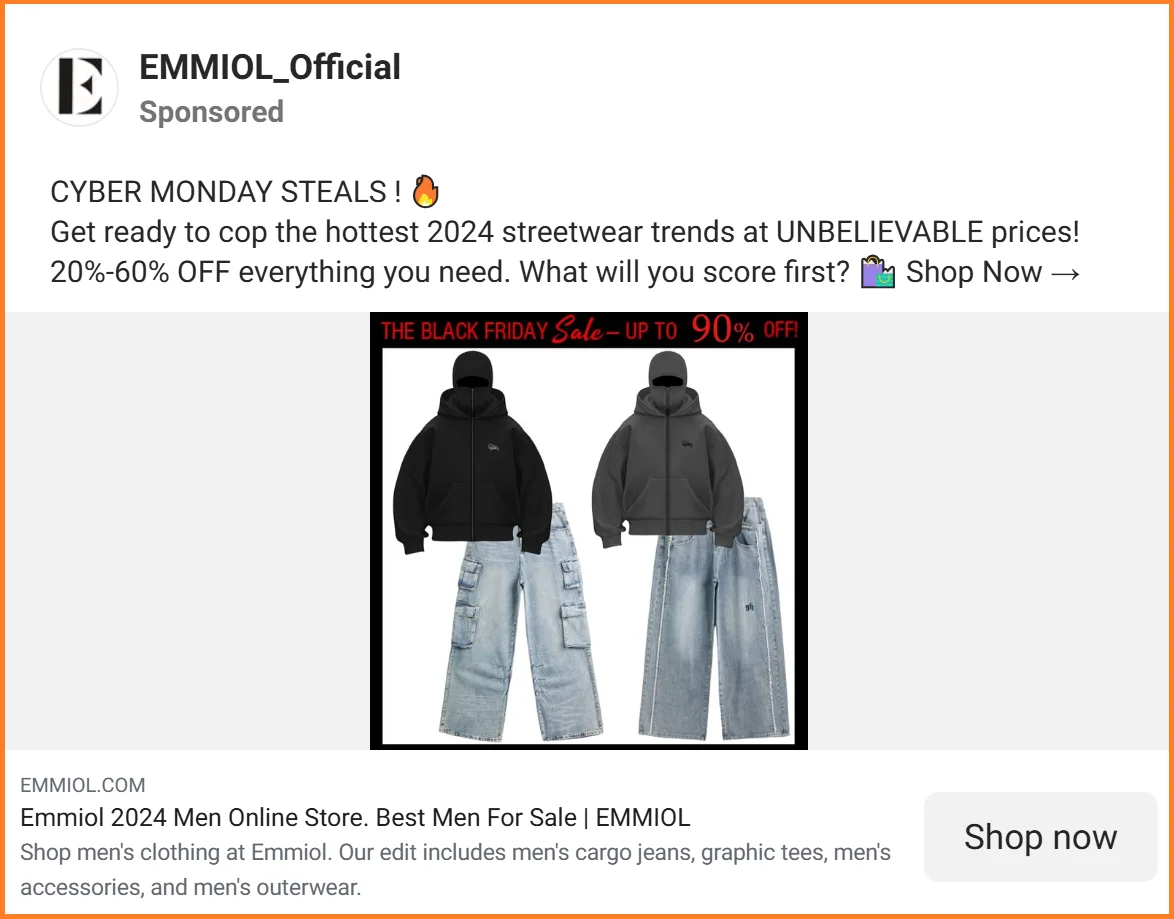
Email may only be a tiny 25% slice of Cyber Monday marketing, but it’s still where the highest ROI sits comfortably. Your goal: use discounts to pull shoppers in and the recommendations to push them to spend more. 🙂
Kipling nails this in their price alert email. Their Cyber Monday email starts with the low price hook: bags from $19.99.
But the recommendations climb naturally: mid-tier bags at $24.99 and a tote at $44.99. The trick is that every product shown is in the same category, just in different colors and styles.
This not only makes the higher value bags feel like an upgrade but also shows choices a shopper would actually consider (‘cause personalization).
Then they stack up perks like free shipping and loyalty points, and close with a fallback offer: 60% off sitewide, with 40% guaranteed. Even if shoppers skip the featured items, there’s still a reason to buy:
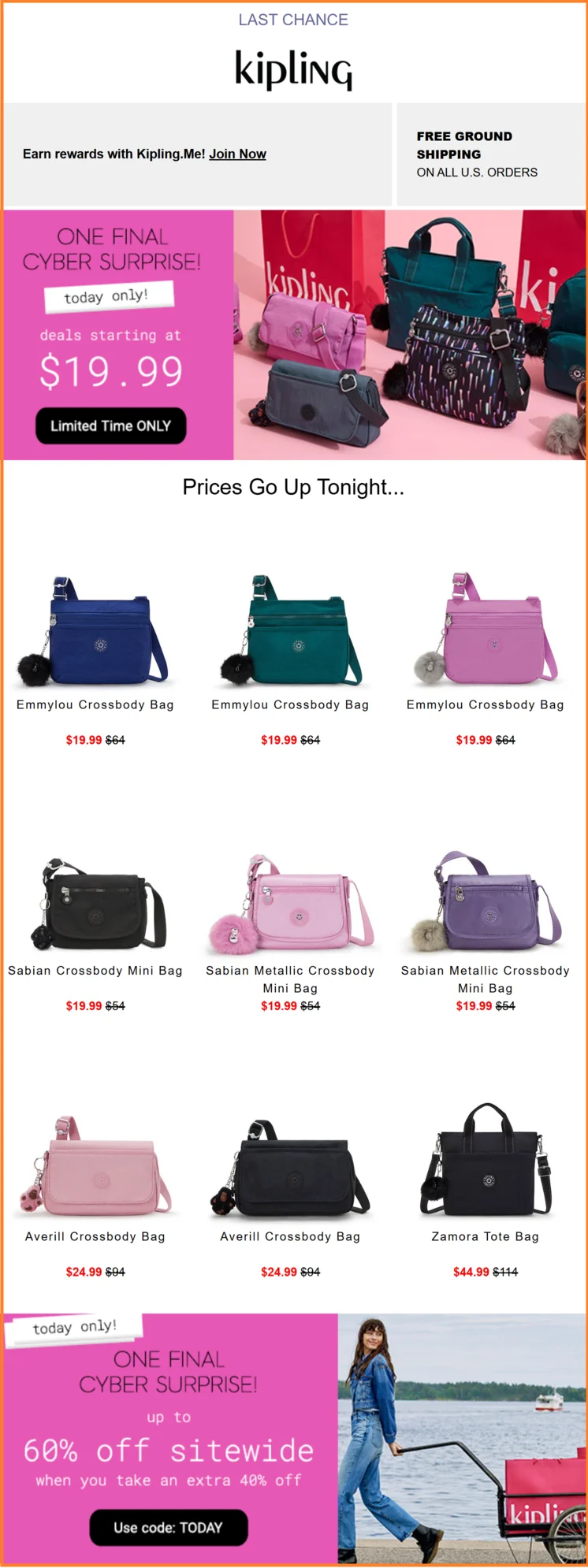
Cyber Monday traffic comes in waves, and one weak link can take your site down. A quick audit now can save you from lost sales later.
Here are the tests you need to be conducting before Cyber Week comes a-knockin':
Load test: Check if your site can handle a 20–40% jump in traffic.
Spike test: Get back to your past data and assess the size of the maximum spike in traffic. The best way, test it in real with a 4-hour flash sale.
Endurance test: See if your site holds steady over days of high traffic.
Stress test: Break it on purpose so you know how your store can fail, and how you can bring it back.
Office Depot went down for nearly four hours during Cyber Monday, 2021 which led to extending its sale to Tuesday.
Scary, isn't it? As an eCommerce growth hack, stress tests can help ensure as little downtime as possible in the event of outages.
Shoppers no longer wait until Monday to start hunting for deals. This is exactly why brands that stretch the sale across Cyber Week win bigger.
Start with smaller discounts over the week before Cyber Monday and keep raising them as the week goes on, and save the deepest cuts for Cyber Monday itself. Here’s what that can look like:
Weekend prior to Thanksgiving: 15–20% off sitewide, free shipping in time for Thanksgiving
Thanksgiving Day (Thu): 20–25% off sitewide + free store pick up
Black Friday (Fri): 25–35% off top categories (electronics, apparel, toys)
Weekend (Sat–Sun): Buy More, Save More bundles (extra 10% off $100+, 20% off $200+)
Cyber Monday Eve (Sun night): Early access for loyalty members or email subscribers
Cyber Monday (Mon): Biggest discounts of the week: 40–50% off select items, limited-time flash deals, and “last call” bundles
Black Friday is an in-store and online shopping event popular in the retail space.
Cyber Monday, on the other hand, is an online-only event where tech gadgets sell like hotcakes.
Black Friday is a major draw for big retailers since they can afford fewer margins.
However, Amazon is an exception since it offers better deals to its Prime members on Cyber Monday.
Here’s a list of FAQs asked by eCommerce brands who’re building their Cyber Monday marketing campaign:
While Black Friday has always been the clear winner, the gap between Black Friday and Cyber Monday has decreased exponentially.
According to an NRF survey, Black Friday outperformed Cyber Monday when it comes to shopping activity by day.
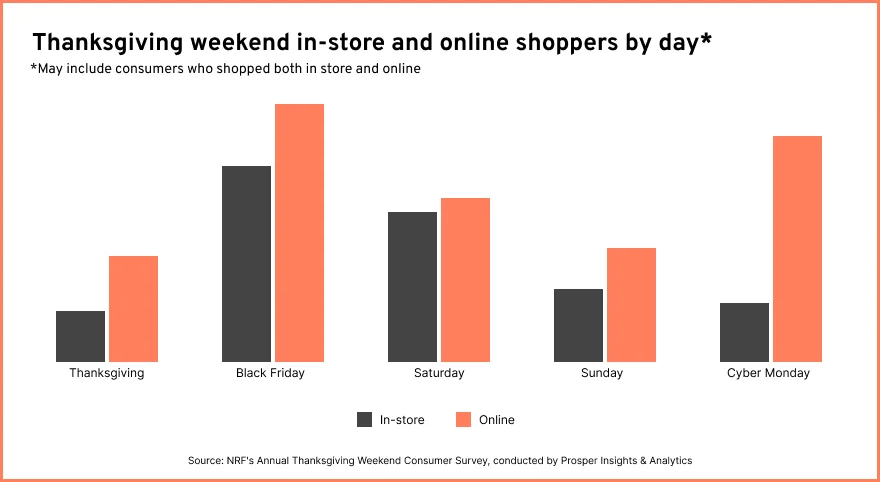
While Black Friday saw an in-store turnout of 66.5 million shoppers and 88 million shopped online( convenience is still the crucial factor), Cyber Monday painted a different story.
With 20.3 million people shopping in-store and 77 million people shopping online, it's safe to conclude that Cyber Monday is still an online event.
Summing up, Cyber Monday is better for tech products. Even shoppers looking to buy from resellers find great deals on eBay.
eCommerce brands sell the remaining inventory of Black Friday on Cyber Monday.
Cyber Monday is highly likely to extend and become Cyber Week.
Cyber Monday is not a public holiday in the US. It’s just like any other day, but the only difference is that the majority of sales happen online.
Businesses are open and sales happen as usual. It’s the busiest online shopping sales event, with its inception on November 28, 2005.
Interestingly, 77% of online retailers opined that their sales increased significantly on the Monday after Thanksgiving, a trend enabling massive online discounts and promotions on Cyber Monday 2005.
Don't forget to check out: eCommerce Marketing Strategies (and Brilliant Examples) for Thanksgiving
As mentioned earlier, the margin of difference between Cyber Monday and Black Friday has narrowed substantially over the years.
Cyber Monday trumps Black Friday due to the highest discounts offered online. The discounts are evenly distributed during the entire Cyber 5 — the 5 days starting from Thanksgiving till Cyber Monday.
In 2020, the median discount rate on Cyber Monday was 29%.
While Cyber Monday offers the convenience of shopping online, Black Friday has the holiday advantage.
People with day jobs can buy on holiday, whereas people can’t take time off to shop on Cyber Monday, which isn’t a public holiday.
However, Cyber Monday emerged as the clear winner, with $10.7 billion in sales against $8.9 billion in Black Friday sales.
The case was no different in 2019, with Cyber Monday grossing $9.4 billion in sales against $7.4 billion on Black Friday.
To conclude, Cyber Monday is slightly higher in terms of revenue, but it isn’t colossal by any standards.
There’s no right answer to this question as the discounts vary by product category.
Black Friday seems to focus on consumer electronics such as TVs, laptops, and smartphones; the discounts on these are the highest. In short, it's great for big-ticket items.
Cyber Monday, in contrast, offers special discounts on home appliances such as coffee makers, toasters, crockpots, stand mixers, and sandwich makers.
As per data, the average discount rate on Black Friday deals was 22% while it was 23% for Cyber Monday.
You will find a price drop on Black Friday for all big retailer products, such as Apple Watch, iPad, and AirPods Pro.
Even TVs are becoming less expensive with retailers like Walmart and Best Buy, quoting their lowest price of the year on most of their top-selling models.
Laptops, desktop computers, and gaming PCs will hit the shelves on Black Friday. Not to forget, you will find steal deals for graphic cards.
Finally, you will also have price cuts on video games that are a rage with gamers on Black Friday.
This is what you can expect on Black Friday.
Are you Black Friday ready? Check out 25 Creative Examples of Black Friday Deals
Cyber Monday is predominantly an online sale on the Monday after Thanksgiving and Black Friday. It’s a 24-hour sale where there’s high demand for tech products from small to medium-sized online retailers.
Unlike Black Friday, Cyber Monday is not a federal holiday. In recent years, Cyber Monday has extended to become Cyber Week, going on till the first week of December.
Cyber Monday is an online-only event that began as a respite for shoppers to avoid the long queues and unpleasant experiences faced on Black Friday, since it is an in-store event.
As per an Adobe survey, the product categories by maximum sales during Cyber Monday 2024 were —
The final prices on Cyber Monday actually dropped, with discounts peaking at 30.1% off electronics, 26.1% off toys, 23.2% off apparel, and 21–22% off TVs and computers.
In short, Cyber Monday isn’t just about gadgets anymore. It’s also for toys, beauty, jewelry, and apparel, right alongside the big-ticket electronics and appliances.